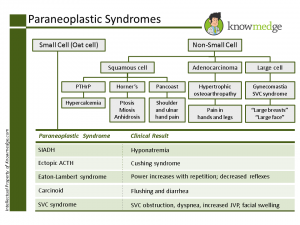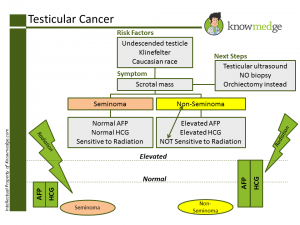7 Oncology Pearls for the ABIM, ABFM and Internal Medicine Shelf Exams
Oncology is an essential part of the Internal Medicine Medical Clerkship, ABIM Board exam, ABFM Board exam and the PANCE Board exam. According to the ABIM exam blueprint, questions testing Oncology topics comprise ~7% of the exam. Initially, oncology seems like a very difficult subject given how the treatment regimens of the many types of carcinomas are ever-changing. However, realize that Internal Medicine exams are focused on the basics of the different malignancies. These 8 pearls will get you off to a good start for identifying high-yield concepts for the boards.
1. Which cancers correspond to lytic bone lesions? Blastic? Lytic or Blastic?
- Lytic bone lesions
- Melanoma
- Multiple Myeloma
- Renal cell cancer
- Thyroid cancer
- Blastic bone lesions
- Prostate cancer
- Lytic or blastic lesion
- Lung cancer
- Breast cancer

Click on image to enlarge
2. Which paraneoplastic syndrome goes with which cancer?

Click on image to enlarge
3. Know these high-yield Breast Cancer facts for the ABIM and IM shelf exams
- If the lesion is >1cm OR the patient has lymph node involvement → chemotherapy will be part of the treatment protocol.
- If sentinel node biopsy is negative → no further lymph node biopsy is required
- If the patient’s breast cancer is ER/PR (+) and patient is pre-menopausal → Tamoxifen is given X 5 years
- If the patient’s breast cancer is ER/PR (+) and is post-menopausal → Aromatase inhibitors (eg. Anastrozole) is given
- If the patient’s breast cancer is HER2/neu (+) → Trastuzumab is given → can cause CHF →check echocardiogram to assess left ventricular function
- Triple negative breast cancer (ER negative, PR negative, HER2/neu negative) have the worst prognosis
4. Don’t let chromosomal translocations overwhelm you
- t (14,18) → Follicular Lymphoma
- t (8,14) → Burkitt’s Lymphoma
- t (9,22) → Known as Philadelphia Chromosome (BCR-ABL) gene fusion → good prognosis in CML patients and bad prognosis in ALL patients
- t (15,17) → Acute promyelogenous Leukemia (M3) → good prognosis → Treatment is with All-Trans Retinoic Acid (ATRA)
- t (11,14) → Mantle cell Lymphoma → highly aggressive form of Non-Hodgkin’s Lymphoma → cyclin D1 oncogene is overexpressed → treat with R-CHOP
5. Testicular cancer is broken down into seminomas and non-seminomas
- Seminomas are Radiation sensitive and usually have a normal AFP and HCG level
- Non-Seminomas (eg, yolk sac tumor, embryonal carcinoma, teratoma, choriocarcinoma) are radiation resistant and usually have elevated AFP and HCG level

Click on image to enlarge
6. High-yield facts about Colon Cancer for the ABIM and IM Shelf Exam
- If cancer invades mucosa or sub-mucosa → colon resection is required
- If cancer invades muscularis propria, serosa, or has LN involvement →colon resection is required +chemotherapy (usually FOLFOX) +/- Irinotecan. FOLFOX is 5 flurouracil, Oxaliplatin, and Leucovorin
- Most common area of metastasis for colon cancer is the liver
- If solitary liver lesion →resection of liver can be performed
- If multiple liver lesions → poor prognosis and survival rate is low
7. Must know Oncological Emergencies
a.) Superior Vena Cava Syndrome → caused by obstruction to the superior vena cava leading to:
- Neck and facial swelling
- Dyspnea
- Cough
- Physical examination will show distended jugular veins
- Chest x-ray may reveal mediastinal widening or right hilar mas
- Most common cause is lung cancer (particularly small cell lung cancer). Malignant lymphoma is also a well-known cause of superior vena cava syndrome
- Management obviously requires treatment of the underlying malignancy but symptomatic measures such as diuretics and elevation of the bed usually suffice
b.) Spinal cord compression
- Most common cancers that cause spinal cord compression are: Lung cancer, breast cancer, prostate cancer, multiple myeloma, and lymphoma
- Back pain is the most commonly presenting symptom. Other concerning symptoms include muscle weakness, numbness/tingling, cauda equina syndrome, and loss of bowel or bladder control
- Diagnosis is required promptly to prevent further neurological deterioration and an MRI OF THE ENTIRE SPINE IS REQUIRED FOR DIAGNOSIS
- Management for spinal cord compression is with Dexamethasone 10 mg IV X 1 dose, followed by Dexamethasone 4 mg IV every 6 hours.
- Radiation therapy can help in shrinking the tumor; however, recent studies indicate that surgical decompression is superior to RT. Therefore, an immediate neurosurgical consultation is required when this condition is suspected or diagnosed.
c.) Tumor lysis Syndrome
- Intracellular contents leak out into the bloodstream.
- Although this condition can occur with any malignancy, it is more common in aggressive lymphomas and hematological malignancies.
- Hyperkalemia, Hyperuricemia, Hyperphosphatemia, Acute renal failure, and hypocalcemia are often seen in patients with tumor lysis syndrome
- Management of tumor lysis syndrome requires electrolyte abnormality correction, aggressive hydration, and allopurinol
Once again, the folks who write the Internal Medicine licensing exams don’t expect you to have the depth of knowledge regarding the plethora of cancer diagnoses that an oncologist possesses. However, topics such as the ones mentioned in the pearls above should assist you with the oncology section of the med school clerkship shelf and ABIM board exams.








[…] Download Plan More @ knowmedge.com […]